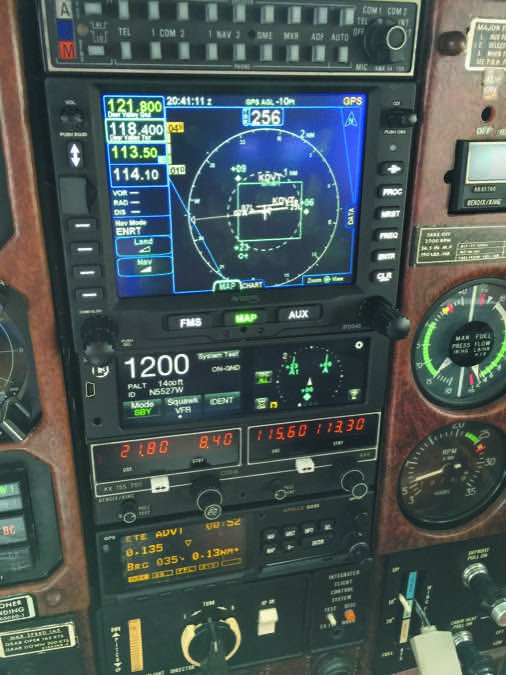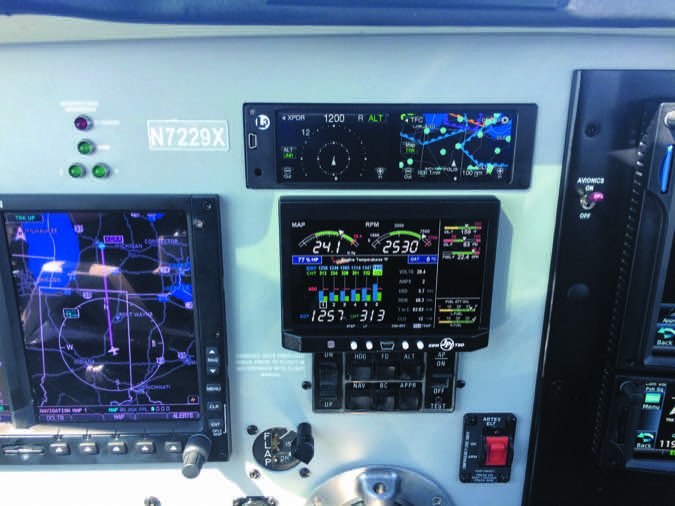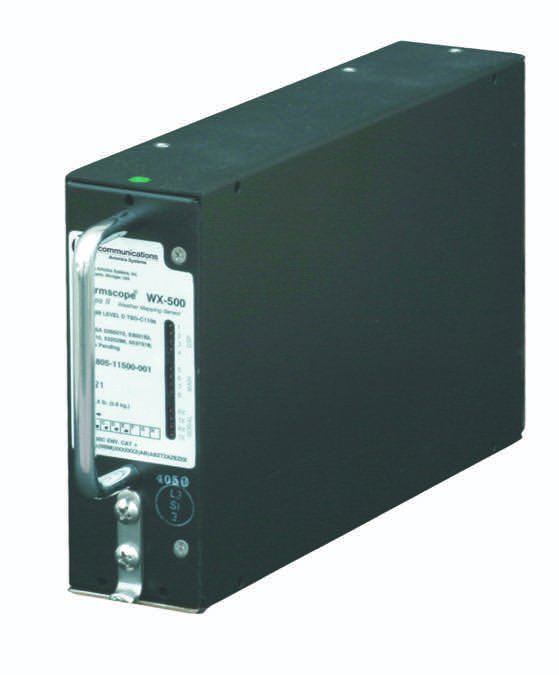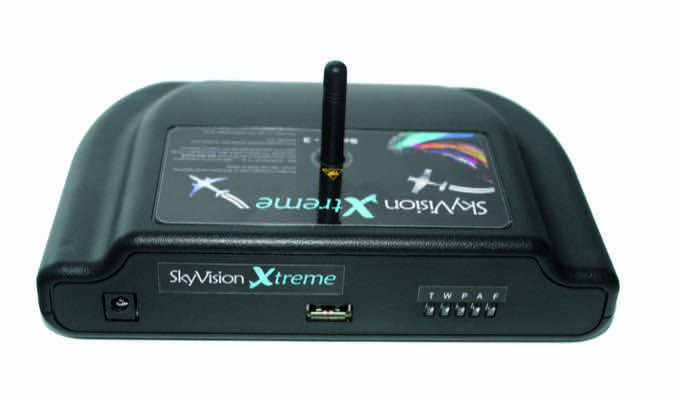When L-3 introduced the Lynx NGT9000 multifunction ADS-B transponder in 2015, we nearly dismissed it for all but the highest-end applications. With a starting price that put it we’ll north of ten grand, the NGT9000 seemed like a questionable investment for buyers looking for an affordable path to ADS-B compliance.
The NGT9000 still isn’t budget priced, but thanks to a growing and competitive market, L-3 dropped the price, making it a serious player in an ADS-B market dominated by Garmin’s new transponders.
L-3 continues to advance the product with new software that provides sizable enhancements, which in turn makes it the most equipped ADS-B solution on the market. Here’s a look.
Right Form Factor
We covered the NGT9000 in other reports (see the April 2015 issue of Aviation Consumer for starters) so we won’t start from scratch here. But to recap, the device has a built-in WAAS GPS receiver, a dual-band ADS-B receiver and it has 1090ES ADS-B output.
L-3 never liked to call the NGT9000 a transponder because it does a lot more, but at its core that’s what it is—a Mode S Class A1/A1S transponder. The new term is smart transponder, with wireless connection to tablets and smartphones.
The NGT9000 fits in a standard 6-inch-wide radio stack and measures just under 2 inches high. It has a footprint similar to most other stack-mounted transponders.
Since ADS-B retrofits and transponder upgrades often go hand in hand, the two-for upgrade strategy is partly why Garmin has enjoyed huge success with its GTX345 series wireless ADS-B transponder.
We think transponder-based ADS-B solutions make the most sense, particularly for a simpler installation, but keep in mind this is a major retrofit that could require antenna work. This may require additional pricey approval on pressurized aircraft.
Are remote UAT systems nearing extinction? We think not, but compare installation quotes. Remote-mount installations (this includes remote transponders, too) may require interior teardown to route interface wires through the cabin. They also require a dedicated display.
The advantage the NGT9000 has over all competitors is a self-contained MFD. For lightly equipped panels—particularly those without multifunction displays and mandate-approved WAAS GPS systems—the touchscreen-equipped NGT9000 packs a punch.
One appeal is the overlay of traffic, FIS-B weather, terrain and Stormscope on the RGB color display. It’s not an easy task cramming all of that functionality on a small screen. But the data is divided among two drag-and-swipe touchscreens and yes, at under 2 inches tall, the NGT9000’s display may not be the best way to view all that data. Think utility.
Spoiled after eyeballing data on large MFDs and on a tablet computer? The NGT9000 will seem small by comparison. But it does have wireless capability for interfacing with a variety of third-part tablet apps, including ForeFlight, WingX Pro and the Seattle Avionics FlyQ. No, it doesn’t work with Garmin Pilot, and an external GPS WAAS can’t be used to feed the NGT9000 the position source; the internal WAAS GPS must be used.
The saving grace is that the GPS signal can be split from an existing WAAS antenna. So if you have a GNS or GTN navigator, for example, the shop doesn’t have to install a WAAS antenna dedicated to the NGT9000. The GPS Networking LDCBS series (roughly $350) is one approved splitter covered in the AML-STC.

ATAS Aural Alerting
The latest software, version 2.1, allows for five new capabilities on new and existing NGT9000s. While the software is free (shop labor isn’t), some of the new capabilities will require additional wiring, plus an upcharge to gain the features through a software unlock. See the sidebar above for what you might expect for costs and installation effort. One major upgrade is ATAS, for ADS-B aural and traffic alerting system.
ATAS surveys and issues traffic alerts for airborne traffic targets at all altitudes, making it especially useful in the traffic pattern. Frequency congestion results in nuisance alerts, so some TAS and TCAS systems won’t scan for traffic below 500 feet unless they’re connected to external mode sensors like landing gear squat switches and airspeed sensors. With its ATAS, the NGT9000 self-filters terminal area traffic and gives collision alerts down to ground level.
Worth noting is a distinct advantage to ADS-B traffic minders compared to TAS simply because of a more complete picture of the traffic threat. Using predictive algorithms, the NGT9000 knows where the threat aircraft is turning, what its exact WAAS GPS position is and precisely where it’s going to be in relation to the host.
The system has two sensitivity levels. In the terminal mode (below 2000 feet AGL) you’ll get traffic alerts within 12.5 seconds prior to what’s called the closest point of approach (CPA) within 750 feet horizontally and 300 feet vertically. Enroute (above 2000 feet), the vertical sensitivity increases to 500 feet. If the CPA is greater than two miles or greater than 850 feet vertically, it won’t issue an alert.


L-3 has gone as far as earning FAA certification (TSO-C195B) for its ATAS function, plus the NGT9000 now has aural alerting that helps put your eyeballs on the traffic. During a traffic alert, you’ll hear “Traffic, five o’ clock, one-half mile,” for example. There’s also a mute button on the screen to manually silence the callout.
If you’re used to flying with TAS or even TIS traffic alerting, avoid the trap of ignoring traffic alerts when flying with ATAS. L-3 made it clear that an ATAS alert means the traffic threat is real and close.
If ADS-B traffic isn’t enough for belt-and-suspender types, the flagship NGT9000 has a built-in active TAS system. Based on transponder interrogation, it emulates L-3’s Skywatch technology, a TAS/TCAS product it sold off.
Since the NGT9000 has a dual-band receiver, alerts generated directly from ADS-B data (both 1090 and UAT) have priority, while active TAS is second and TIS-B uplink is third.
L-3 says the combination of active TAS (you’ll have to buy the $8000 TAS-equipped unit to get it) combined with ADS-B traffic alerting provides the best traffic alerting of any ADS-B system on the market. It certainly is the most complete.
If you already have an L-3 Skywatch installed, the existing NY164 directional antenna can be used to complete a diversity (dual antenna) interface, which helps eliminate shadowing.
Terrain and Stormscope
Just when we thought lightning detectors were headed for retirement (they’re overshadowed by SiriusXM and ADS-B weather systems, plus they’re expensive to repair), L-3 adds Stormscope display capability to the NGT9000.
While there are many Stormscope models still in service (there were over 60,000 built), only the L-3 WX500 will work with the NGT9000. This is the two-piece remote system (processor and antenna) that connects with a variety of panel displays. We doubt new WX500s will be flying off shelves because of this new interface, but we also think having the capability adds another tactical resource to FIS-B ADS-B radar, especially when you consider the resolution limitations.
The Stormscope is controlled and displayed on a dedicated page in the NGT9000. You can view cell mode or strike mode, overlay lightning data on the map page, plus control the 200-mile range. Since the WX500 can drive two displays via its twin serial output ports, you can still keep it connected to an existing system.
If you have a Garmin navigator, GMX200 or Avidyne MFD, to name a couple among a long list of compatible systems, they can be used as secondary, non-controlling displays. The WX500 can also provide a magnetic heading source to the NGT9000 if the Stormscope is wired for synchro magnetic heading.
There are now two options for terrain alerting on the NGT9000 and both trickle down from L-3’s LandMark TAWS-B system. For turbine-category aircraft that have to have a mandate-compliant Class B TAWS system, L-3 offers the $4000 eTAWS option. One of the requirements of TAWS-B is aural and visual alerting during CFIT conditions.
But you don’t always need TAWS-B in pistons. For that crowd, L-3 added TerrainVision. This is an $893 option that doesn’t have the aural alerting or forward-looking predictive capabilities of a full-up TAWS-B system, but it does have the same terrain color/altitude clearance display. When enabled, TerrainVision appears on the NGT9000’s right display.
Smart Improvements

Software 2.1 also has some subtle enhancements, including the ability to more efficiently use dual NGT9000s in one panel (one acts as a primary MFD, while the other handles transponder and ADS-B Out functions, for example).
Additionally, L-3 said many NGT9000 customers who operate in the SFRA and ADIZ zones requested to disable the single-button VFR squawk mode to guard against inadvertently squawking 1200 when flying in those areas, so it added the capability in the new software.
The base price of the NGT9000 is $6170, but the ATAS and TerrainVision capability bumps the price to $7730. With built-in TAS, it’s $11,750 including antenna. You can add ATAS and TerrainVision to existing NGT9000s for $667 and $893, respectively.
For buyers looking for a cheap ADS-B upgrade, the NGT9000 probably isn’t the system. But for panels that don’t have an MFD and are begging for a transponder upgrade, we think the NGT9000 makes sense.
Contact www.l-3lynx.com.
See a video about the NGT9000 at http://tinyurl.com/j95ht2a
What’s All That Going to Cost?

As is often the case with avionics installations, more external interconnection means more teardown and more time on the hangar floor. That results in a bigger invoice. To take advantage of the NGT9000’s new functions, plan on all of the above.
If you want the $667 ATAS aural alerting (a feature we think is worth the effort to hook up), you could find yourself biting the bullet and finally buying a new audio system. New ones have plenty of unswitched audio inputs for accommodating the alerting. If you already have an audio panel that will work, you might spend a few hours of shop labor to hook it up. Round numbers, plan on $500 extra for typical radio stacks, according to two shops we talked to. Pulling the trigger on a new audio panel installation—especially in aircraft that haven’t seen an avionics upgrade in years—could mean spending a few thousand dollars for a modern one with intercom stations.

As for the new Stormscope interface, your shop could need to add or swap around the wiring because the NGT9000 has to be the main and controlling display in a multi-display setup. Add roughly another $500 if the wires are accessible. All in, a new base-model NGT9000 retrofit could approach or even crack $10,000.


It’s Time to Relax the ADS-B TSO
Last month, Seattle Avionics began marketing a new portable dual-band ADS-B In product from uAvionix. It’s called the pingBuddy2 and sells for the eye-opening price of $149.
The pingBuddy2 is significant for a couple of reasons. One is the utterly disruptive price. Heretofore, the dual-band portables have sold for nearly 10 times as much. We’re thinking here of the Stratus 2S, the Sagetech Clarity and the Levil Technology iLevil 3 SW. To be sure, these aren’t exact comparisons because the more expensive products include onboard GPS and AHARS that put some backup gyro capability on a tablet. One version of the iLevil even has pitot-static input. By comparison, the pingBuddy2 has just ADS-B In for TIS-B and FIS-B access. You’re on your own to provide it with GPS position data.
The bigger picture is that uAvionix, looking forward, is leveraging volume in the drone market to effect some interesting economy of scale. At this point, it’s somewhat aspirational volume because the requirement for ADS-B on drones hasn’t materialized yet. Our guess is it will, but it will take a while. But uAvionix, with its full line of miniature avionics, is betting on that future.

The plus for GA owners and pilots is that even though uAvionix’s market is overwhelmingly in the UAS space, it sees some opportunity to disrupt ADS-B prices for manned aircraft. As we go to press, the company announced several ADS-B products for the experimental and LSA market. As with other non-certified ADS-B products, there’s a significant price break compared to TSO’d equipment. Could that eventually result in significantly cheaper ADS-B Out solutions for owners still balking about equipping? Maybe.
But “significant” is in the eye of the beholder and the trick part here is will the vastly larger demand for UAS ADS-B materialize before the 2020 mandate deadline? Our guess is it won’t, because the FAA hasn’t even settled on regulations for the larger drones that will fly in the airspace with manned aircraft, much less figured out how and when to require ADS-B for Part 107 operations.
The argument for those little drones having ADS-B—and you equipping your airplane—is compelling. The low-power systems uAvionix is producing don’t need to ping ground stations or pipe data into TIS-B or be engaged with ADS-R. They need a simple ADS-B Out pulse so you can see them in your equipped airplane. If you’re really worried about the risk of colliding with a small drone, that’s the argument for equipping both aircraft with ADS-B.
As a point of public policy, the FAA should now look at the potential of volume-driven ADS-B equipage and how it could reach its goal of full participation. Despite all the positive spin you may have heard, the rate of equipage is still lagging. Whether that’s related to cost or other factors is anyone’s guess. Vastly cheaper ADS-B Out solutions can’t hurt the effort and may ignite the torrent of demand the FAA so desperately wants.
The $1100 SkyVision Salus-3 is one product that’s positioned to do just that. It’s a portable that has ADS-B Out and In, WAAS GPS, a transponder control module for keeping the Mode A codes in sync with the ADS-B data, plus it has an external ADS-B antenna input in addition to the integral stick antenna. That’s the current Salus-3 in the main photo.
While the device supposedly meets all of the performance specs of TSO 154C, company founder Harry Sanders told us the FAA won’t issue it a TSO because it’s convinced portable units aren’t reliable. Still, FAA ADS-B performance reports gathered by existing owners prove the Salus-3 is just as reliable and accurate as any TSO’d ADS-B system. We flew with a Salus-3 for a report in the June 2015 Aviation Consumer and it worked, but had limited third-party app interface.
Aside from a low price and avoiding a pricey teardown installation, the idea of a portable ADS-B Out device is the ability to carry it from one aircraft to another. This can save struggling flight schools a small fortune in upgrades. Simply program the aircraft-specific ADS-B data in the tablet app before starting the engine (that’s what we did with the Salus-3 when we rented a Cherokee for the flight evaluation) and away you go.
To achieve widespread equipage, we think the agency needs to relax—or even eliminate—the TSO requirement for certified ADS-B. It’s lunacy and utterly counterproductive that an experimental RV-8 can run around in the same airspace that a Skyhawk can, but the latter requires a more expensive certified ADS-B receiver. This is at the core of the squabble NavWorx is having with the FAA, which insists that the company’s GPS solution for its low-cost ADS-B boxes doesn’t meet the TSO requirement, even though it meets the TSO performance specs. The FAA is just making it that much more difficult and expensive to equip over what we think is an inconsequential technical fine point.
Removing the TSO and certification hoops would make it much more likely that a company like uAvionix could bring cheaper ADS-B to the market. Could we see an under $1000 solution suitable for certified airplanes? uAvionix thinks so, especially if the drone demand it sees over the horizon materializes. But it may not be in time to meet the 2020 witching hour. Still, better late than never.
And while we’re at it, why not just reconsider the entire idea of TSOs? It’s an idea whose time may be done.


